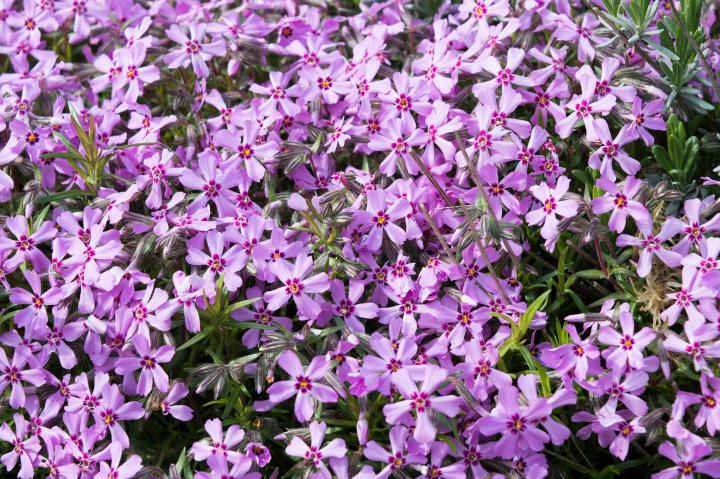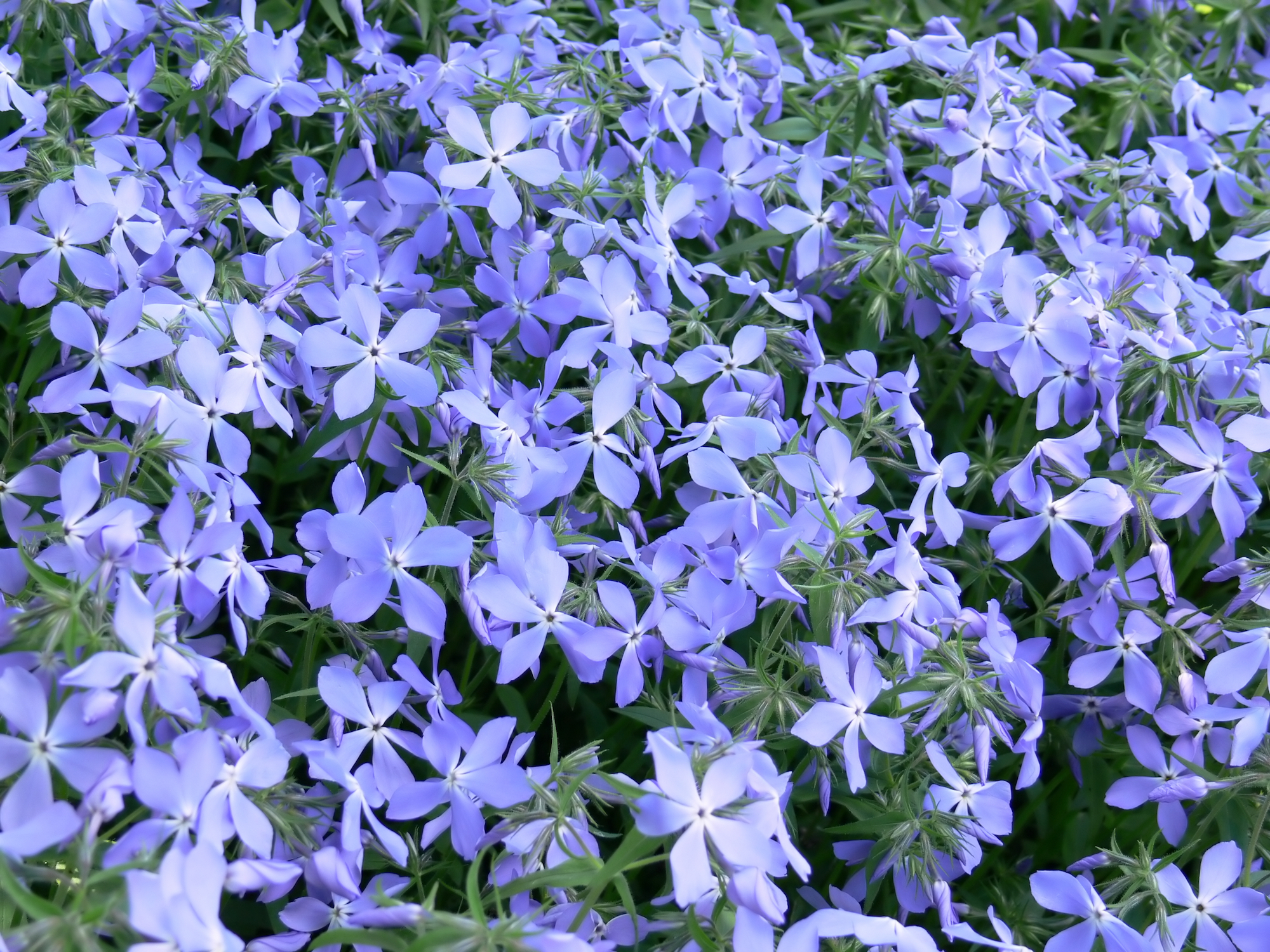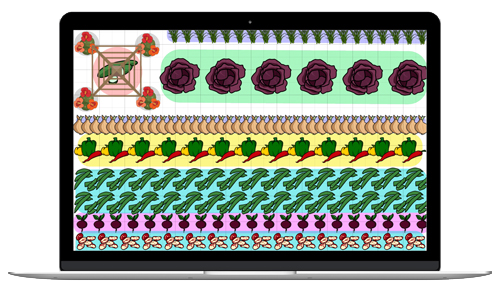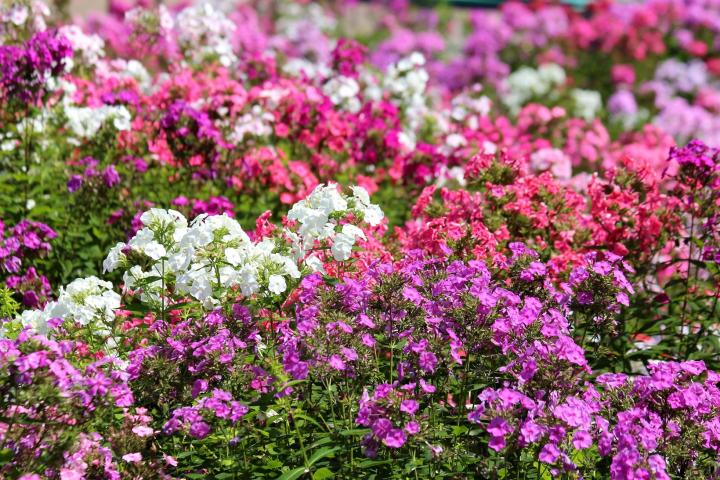
Planting, Growing, and Caring for Phlox Flowers
The Almanac Garden Planner - Use It Free for 7 Days!
Plan your 2025 garden with our award-winning Garden Planner.
Types
You just can’t go wrong with phlox! Here are some of the best species and varieties to try:
Low-Growing Phlox
- Creeping phlox or moss phlox (Phlox subulata) is a low-growing species that works excellently as a ground cover. It spreads slowly, growing in mounds that get 4–6 inches thick. The whole plant turns into a carpet of color in spring, when flowers cover every square inch of foliage. This phlox is particularly stunning when allowed to drape over a rock wall—imagine a waterfall of color! Creeping phlox grows best in well-drained soil and partial to full sun.
- ‘Candy Stripe’ is a popular variety with pink-and-white–striped flowers.
- ‘Emerald Blue’ produces a sea of lilac-blue flowers (perfect for that waterfall of color!).

- Phlox stolonifera, which also goes by the common names creeping phlox and moss phlox, is similar to P. subulata in name only. The main differences between it and P. subulata are that its leaves are oval-shaped (rather than needle-shaped), and its flowers are produced on stems that rise 6–10 inches above the foliage (rather than directly on the foliage). It prefers a shadier growing site with rich, evenly moist soil.
- ‘Sherwood Purple’ is a delicate little phlox with purplish-pink flowers.
- Woodland phlox or blue phlox (Phlox divaricata) is another low-growing species. As its two common names suggest, it prefers partial to full shade and moist, rich soils and produces bluish flowers in early spring. Like P. stolonifera, its flowers bloom on stems that rise about a foot or so above the creeping foliage.
- ‘Chattahoochee’ and ‘Blue Moon’ are two great varieties with beautiful blue-to-violet flowers.

Medium-Height Phlox
- Annual phlox or Drummond’s phlox (Phlox drummondii) grows as an annual rather than a perennial, unlike most other phlox species. Annual phlox rarely grows taller than 2 feet in height. Most varieties are not very heat tolerant, but in warmer regions, you may find the heat-tolerant varieties for sale. Plant in well-draining soil in a site that gets partial sun and doesn’t stay too wet.
Tall Phlox
- Garden phlox or summer phlox (Phlox paniculata) is the tallest phlox in cultivation and is probably the species that most folks have in their gardens. It grows in clumps that reach between 3 and 5 feet in height and produces panicles of flowers in mid- to late summer. Though tolerant of most lighting, it grows and flowers best in partial to full sun. It has a reputation for being very susceptible to powdery mildew, but resistant varieties are available.
- ‘David’ has bright white flowers and is resistant to powdery mildew.
- ‘Jeana’, another mildew-resistant variety, produces panicles of petite purplish flowers—similar in appearance to a butterfly bush.
Other Phlox
The phlox listed above are just a few of the many species out there. Others of interest to gardeners may be Carolina phlox (P. carolina), meadow phlox or spotted phlox (P. maculata), and sand phlox (P. bifida).
ADVERTISEMENT
1. Can You Grow Phlox in Pots? Yes, you can grow phlox in a large pot, keeping it outside in spring and summer and in an unheated garage or shed in the winter. You’ll just want to make sure that the potting soil doesn’t dry out entirely at any time; while in winter storage, keep it lightly moist but not as much as you would in spring/summer, while the plants are actively growing.
2. How Do You Deadhead Phlox? By using a technique called deadheading, phlox can be encouraged to keep producing flowers. Deadheading simply involves snipping off the top cluster of flowers that have finished blooming, while leaving any lower flower buds alone. These lower buds will appear just above the leaves. When making the cut, leave about half an inch of stem above the highest buds.
Mine had just gotten to the point of spilling over my wall, winter came and a snow plow took out my wall and ripped up one of my plants. I have another that is cascading down the garden can I take some of that and plant it up by the wall that has been rebuilt, or do I start over with a new plant?
Phlox transplants quite well, so if you can take a chunk of the existing plant that has some roots on it, you shouldn’t have any trouble getting it to grow on top of the wall!
does every blossom produce a seed / i'll only found a few seeds that are about 1/8 " dia. / is divide-separate 2-3 yrs the only way to expand the bed / thanks
When I was young we had what was called Thrift, it was a beautiful ground cover and is very common in N. Ga. is this the same as Phlox? I tried to move it from my mom's house to mine, but it died. Just wondering if this is the same plant? Thanks
I have several large beds of talk phlox. I don't know where they came from, but they self seed every year. So every year I have larger and larger plots of phlox. This is a minimal care plant. I live in northern Nevada. I've given these plants to everyone with the caution that they spread easily. The flowers stay for a long time and are pretty. Butterflies, bees, and hummingbird moths love these. It's fun to watch the moths. Usually in the early evening after dusk. I do cut it down in the spring, so it's not so messy looking. Doesn't require a lot of water.
I have grown phlox before in Wisconsin but now I am in South Carolina and every time that I purchase phlox, the flower petals immediately begin to fall off. I know not to water the flower or foliage but try to just water the soil underneath. I am not sure whether I am overwatering, as it gets very hot here in South Carolina.
Assuming you are transplanting them from their nursery pots to a container or the soil, there is a phenomenon called “transplant shock,” which may occur shortly after you transplant a plant into a new environment, especially if the new environment has very different conditions (more light, more heat, less water, etc.). The plant may drop its flowers or some of its leaves in order to prioritize producing new roots. It sounds like this is what’s happening with yours, made worse by the heat of summer. After it is planted and settles in, the phlox should produce new flowers. Do yours?
Alternatively, it could be that the phlox is not used to so much sun and heat. It may have lived a more sheltered life in the nursery, so perhaps try keeping it in partial sun for a week or so when you first bring it home, then move it into full sun.
I Havre standing phlox that have turned Brown what should I do
WHY don't you say how deep to plant tall hardy phlox??










